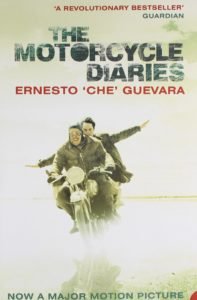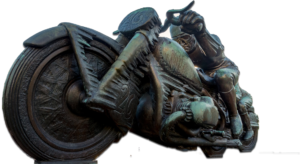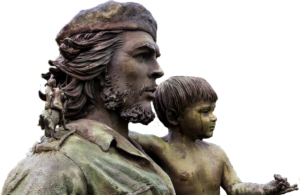
Author: Ernesto “Che” Guevara
Publisher: Ocean Press and the
Che Guevara Studies Centre
Translated by: Alexandre Keeble
Published in Havana in 2003
Total no. of pages: 165
Ernesto “Che” Guevara. This name, whenever used, brings four words to everyone’s mind: revolution, Marxism-Leninism, freedom and Guerrilla rebellion.
As Time magazine’s one of the 100 most influential people of the 20th Century and “icon of the century”, Ernesto Guevara is undoubtedly one of the most famous revolutionaries in world history. He has become a symbolic figure for those who believe that human exploitation, oppression and all kinds of social injustices can only be wiped out by revolutionary means,i.e. by becoming a Guerrilla. The Guerrilla, according to Guevara, is the highest form of human revolution in which one is ready to sacrifice everything, including one’s life, for the cause and the ideas that one believes in.
Born on May 14th, 1928 in Rosario, Argentina, to an upper class family of Spanish-Irish descent, Ernesto Guevara de la Serna had a privileged childhood far removed from poverty or any other kind of social injustice. Guevara was born with a severe asthmatic condition due to which his parents had to move to a place with a drier climate, finally settling down in Alta Gracia. He was the eldest child to his parents, with four younger siblings; two brothers and two sisters.
Guevara later on went to a medical school in Buenos Aires to become a doctor. Passionate about travelling, Ernesto at the age of twenty one, along with his friend Alberto Granado, decided to go on an adventure and explore Latin America on a motorcycle in December 1951, from his home in Córdoba, Argentina. Granado was a couple of years older than him, and a microbiologist who at that time was doing his research on lepers near San Francisco del Chañar.
Also Read: ‘WATER HOLDS WATER TOGETHER’
Ernesto had only one year left to graduate from medical school but he was so frustrated with his monotonous life that he decided to put his degree on hold for a year and set out on this adventure that later became the subject matter for the famous book (published many years after his death in 1995) and the blockbuster motion picture with the same title, The Motorcycle Diaries.
As Guevara writes in The Motorcycle Diaries, “The enormity of our endeavour escaped us in those moments, all we could see was the dust on the road ahead and ourselves on the bike, devouring kilometres in our flight northward”, one can very easily sense the excitement and the passion Guevara had for travelling. Starting from Buenos Aires on January 4, 1952, after bidding farewell to Ernesto’s family, both Alberto and Ernesto hopped onto their motorcycle called La Poderosa II (The Mighty One II) and set off on a road trip through South America.
They travelled to the Atlantic coast of Argentina and across the Pampa to the south of Argentina. They reached San Carlos de Bariloche on February 11, 1952, crossed the Andes Mountains and entered Chile. La Poderosa II, given the condition that it was in, was on the verge of giving up and as they were near Santiago, the capital of Chile, the motorcycle breathed its last. From then on, Ernesto and Alberto were forced to walk long distances in extreme weather conditions, hitchhiking, and using whatever means of transport that was available to them to continue their journey. In fact, Ernesto and Alberto travelled on almost every type of transport available to them, from horses, railroads, trucks, rafts to buses, ferries, boats and even airplanes.
They were short of money throughout the entire trip and were forced to work at numerous odd jobs to continue their journey. Unable to get a boat to Easter Island as they had initially intended, they eventually ended up in the famous Chuquicamata, which Guevara expresses as being“…like a scene from a modern drama. You cannot say that it is lacking in beauty, but it is a beauty without grace, imposing and glacial”.Guevara describes Chuquicamata as a dry, arid desert with a nitrate soil where not even a single blade of grass can grow. Chuquicamata is the world’s largest copper mine with 20-meter high terraces cut into enormous sides from where the extracted mineral is easily transported by rail. “Chuqui” as it is still known in Chile today, was owned by US monopolies such as Anaconda and Kennecott. US ownership of the mines at “Chuqui” was a symbol of imperialist “gringo” domination in Chile. They were eventually nationalised by the Popular Unity government, led by Salvador Allende of the Socialist Party, between 1970 and 1973” Chuquicamata had a huge and everlasting impact on Guevara who for the first time in his life encountered poverty, deprivation, social injustice, human exploitation, discrimination and oppression. This was his first face-off with the harsh realities of the lives of those who are socially deprived. Here, he met a communist couple who were in exile and had left behind their only child with their parents. They were in a pathetic condition, starving and had no means to protect themselves from the biting cold. Guevara, being a very sensitive person, was deeply affected by seeing the unfortunate condition of this couple, and as a result tried to help them in whichever way possible but the impact that they had on him stayed with him for the rest of his life and changed his whole perception about society and life. Here Guevara noted in his diary that “Chile offered economic possibilities to anyone willing to work as long as he is not from the proletariat” and went on to write that “…the main thing Chile has to do is to get its tiresome Yankee friend off its back, a tiresome task, at least for the time being, given the huge US investment and the ease with which it can bring the economic pressure to bear whenever its interests are being threatened”.
This clearly makes the political stand of Ernesto Guevara very apparent. From here one can very easily describe Guevara as someone with a communist ideology. He felt deeply for the poor and the weak and treated everyone equally irrespective of their class and ethnicity. He vehemently endorsed the ideas of Karl Marx regarding the equal distribution of wealth and the overthrow of the bourgeoisie class. He acknowledged the fact that there was a class division and the poor were in a terrible condition and there was a desperate need to end capitalism and replace it with communism.
After Chuquicamata, Ernesto and Alberto hitchhiked to Peru where they came across the exploitation and the suffering of the Indigenous peoples who were called Indians by the colonisers. They saw how the “Indians” of the high plateau were exploited and oppressed. In his writings, Che calls them a “defeated race” that has been under Spanish colonisation for centuries now and is not the same proud race that they once were when they revolted against the Spanish. He notes that “they look at us meekly, almost fearfully, completely indifferent to the outside world”. Guevara shows a lot of concern about the living conditions of the Indigenous peoples and how they were treated mercilessly by their Spanish masters. He criticizes how the wealthy Peruvians expect the Indigenous population to do any and everything and treat them like donkeys that can carry anything on their backs no matter how much the load.

Interested in leprosy, both Granado and Guevara took a detour and went to Lima, the capital city of Peru where they met Dr. Pesce, a disciple of José Carlos Mariátegui, a Peruvian Marxist philosopher. Pesce was forced into exile and was living a highly principled life dedicated to the common good. Here, they both decided not to go to the US and instead ended their journey in Venezuela.
The Motorcycle Diaries depicts the growing consciousness of Ernesto politically as well as socially. His early inclination towards socialism started to take proper shape after having first-hand experience with extreme living conditions grounded in social injustice, human exploitation and oppression that he saw prevailed throughout the entire Latin America. He was determined to do something to put an end to the agony of the ‘proletariat’ and after graduating in 1953, and giving up his comfortable privileged life, Ernesto Che Guevara started his second Latin American odyssey.
“Che”, as he was affectionately called by the Cubans, is the greatest revolutionary history has witnessed. He was inspired by Marxist ideology and went on to declare himself as one when Salvador Allende, the socialist and left wing candidate, was elected as the President of Chile. He believed that the reason for poverty and oppression are capitalism and imperialism and concluded that the solution to these problems is communism.

In June 1954, the reformist Guatemalan government of Jacobo Arbenz Guzman was overthrown by the CIA-orchestrated coup that then installed a harsh, brutal right wing regime, resulting in decades of oppression. Since it was a Central American nation where Guevara’s road trip culminated, he felt a deep resentment against the imperialist and capitalist US. It ended up transforming Guevara into a fully aware socialist revolutionary who from that very moment devoted his entire life to liberate every ‘third world’ country from imperial and capitalist domination.
As an important text, The Motorcycle Diaries gives a substantial insight into the early formation years of Ernesto Che Guevara as he transitioned from a young man of considerable privilege to a revolutionary in the making. The text traces his journey from place to place throughout Latin America as he surveys the state of affairs of dispossessed and oppressed peoples and their difficult conditions. The text is a must read for those interested in finding commonalities with a variety of struggles all across the globe and also for those interested in the history of struggle of the Latin American peoples, narrated through the particular perspective of the most recognised revolutionary from that part of the world.
Advertisement


